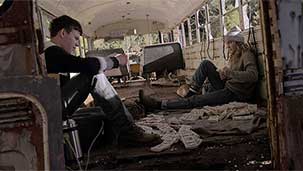It is difficult to overemphasize the importance of a cinematographer when talking about the quality of a film. They are often the difference between an otherwise perfectly competent film and something that really sticks to your eyeballs.
A cinematographer is involved in making choices about lighting, deciding upon digital or film, what lens to use, and how to most effectively convey each moment up on the screen. To do this well requires an almost intuitive understanding of the director’s vision. A good cinematographer can help refine and even improve the transition between what is in the director’s head and the finished product.
Mean Dreams is a fine example of exactly this kind of simpatico relationship.
Shot mostly in natural light and in a rural setting, Mean Dreams is, on the surface, a fairly conventional story. Two isolated teens find each other, fall in love, and then almost immediately become enmeshed in a plot involving revenge, parental abuse, and eventually drugs and murder. What saves this film from being nothing but a weak echo of Malick’s Badlands, or other similarly themed films, is its gentle, almost poetic tone.
Mean Dreams is a subtle film, with the single exception of Bill Paxton’s slightly overwrought performance. Muted colors, introspective, self-contained characters--especially Sophie Nelisse and Josh Wiggins as the two young leads--and a deliberate pace all help illustrate the fixed, repetitive nature of the rural environment. So when the two young lovers’ lives intersect and things begin to change, it adds a multiplying effect to their fraught circumstances that doesn’t require a booming score, or quick successive cuts.
Nelisse and Wiggins have a quiet chemistry that makes them compelling and sympathetic, which meshes well with both the minimalist visual sense and bare bones script. You come to believe these two might well fall in love--which adds some real emotional weight to their predicament.
Mean Dreams also artfully portrays the sometimes drab and hardscrabble life of small scale farming through an intentionally limited palette, long takes of desolate countryside and artfully framed shots of run-down structures. This stifling existence is so effectively conveyed in the visuals that the dialogue can afford to remain spare and understated.
Ultimately, despite all these positives, Mean Dreams doesn’t quite connect on a purely emotional level. While these characters are interesting throughout, the score is effective, and the visuals mesh almost perfectly with the overall tone of the film, the underlying plot feels mechanical. This kind of clockwork effect undercuts the drama, because each twist in the road feels inevitable instead of surprising.
Even though the skeleton of the story is the weak link in Mean Dreams, there is a lot to like in this often engaging, and always quietly beautiful film. And while you can’t be responsible for the quality of the vision you’re helping to bring to life, you seem to have done everything you could to faithfully translate that vision from concept to reality.
Sincerely,

Tim
Don't let mean control your dreams - sleep easy with this!
Check out this DC&C Special Tie-in today.







